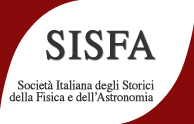Conveners
Musei, Archivi e Strumentazione scientifica di fisica e astronomia in Italia e nel mondo / Museums, Archives, and Scientific Instruments of Physics and Astronomy in Italy and Abroad
- Roberto Mantovani
Musei, Archivi e Strumentazione scientifica di fisica e astronomia in Italia e nel mondo / Museums, Archives, and Scientific Instruments of Physics and Astronomy in Italy and Abroad
- Chairperson: Roberto Mantovani
Musei, Archivi e Strumentazione scientifica di fisica e astronomia in Italia e nel mondo / Museums, Archives, and Scientific Instruments of Physics and Astronomy in Italy and Abroad
- Chairperson: Roberto Mantovani
Musei, Archivi e Strumentazione scientifica di fisica e astronomia in Italia e nel mondo / Museums, Archives, and Scientific Instruments of Physics and Astronomy in Italy and Abroad
- Chairperson: Roberto Mantovani
Musei, Archivi e Strumentazione scientifica di fisica e astronomia in Italia e nel mondo / Museums, Archives, and Scientific Instruments of Physics and Astronomy in Italy and Abroad
- Chairperson: Salvatore Magazù
As part of its cultural protection activities, the Superintendency of Archaeology, Fine Arts and Landscape for the metropolitan city of Genoa and the province of La Spezia intends to advance a project to inventory and study the collections of assets pertaining to the Scientific and Technological Heritage present in its territory.
This inventory aims to involve different institutional entities...
The Specola Museum in Bologna is about to reopen with a fully redesigned exhibition, offering a renewed interpretation of the historical Astronomical Tower and its scientific and cultural legacy. Built between 1712 and 1726 on the initiative of Luigi Ferdinando Marsili, the Tower served as Bologna’s observatory until the opening of the Loiano Observatory in 1936. Today, its rooms house three...
The idea of founding a permanent museum dedicated to the illustrious Polish astronomer dates back to 1873, the year of the fourth centenary of the birth of Nicolaus Copernicus (1473-1543), and was the result of an initiative proposed by former Minister of Public Education Domenico Berti and Filippo Serafini, rector of the University La Sapienza. Since then, a series of intricate events...
We explore the origins of the Physics Cabinet of the University of Naples. Using archival documents, instrument inventories and other primary sources, we reconstruct the complex history that led to the first collections of instruments in the Cabinet's premises at the beginning of the 19th century. Particular attention will be paid to the specific role of the professors, the instrument makers...
This paper will present the results of the research that had been carried out over an historical scientific instrument, a dividing engine part of the collection of the Gabinetto di Fisica of the Seminario Vescovile in the city of Cremona that was under conservation treatment by myself. During this study a fragment of a sundial was found, used as part of the engine. Further analysis confirmed...
The Torlonia telescope has recently been the subject of studies that have highlighted its value for the development of science in the Papal States, in 19th century. This renewed interest was made possible through a process of restoration and valorization.
Rome had a long tradition of astronomical studies and the telescope became a symbol of a period when scientific thought was promoted both...
"Culture is humanity's only asset that, when divided among all, instead of diminishing becomes greater." When Gadamer spoke these words, the reality of the web had not yet established itself. Today, alongside traditional means of communication, we find a series of allies that allow for the widespread dissemination of culture. This is the case of the new visiting project at the museum *La...
At the end of 1863, Heinrich Wild, physics professor at the University of Bern, conceived the polaristrobometer, a groundbreaking optical instrument designed to measure the rotation of polarized light caused by crystalline substances and organic compounds. The polaristrobometer was developed in two versions: a compact handheld model and a larger tripod-mounted device. This presentation focuses...
In 1965 the variable-frequency relativistic cyclotron of the Institute of Physical Sciences of the University of Milan went into operation. The cyclotron was used in various fields of nuclear physics research and its applications in the medical and technological fields, accelerating particles, mainly protons, up to an energy of 45 MeV. The analogue-digital computer is the only part of the...

